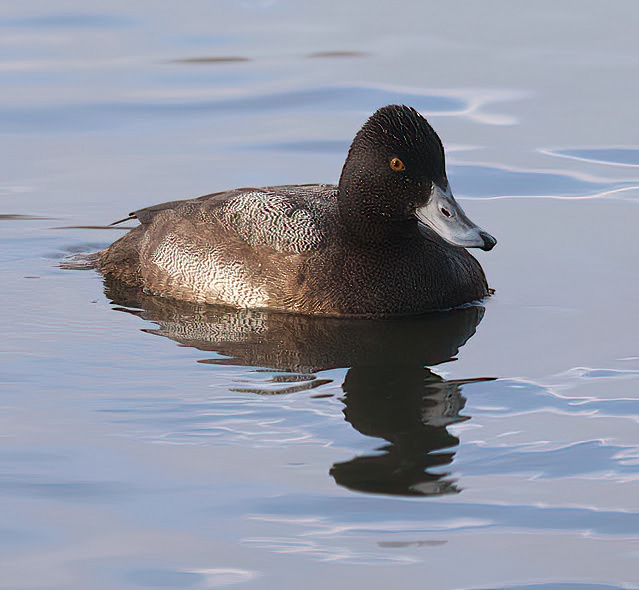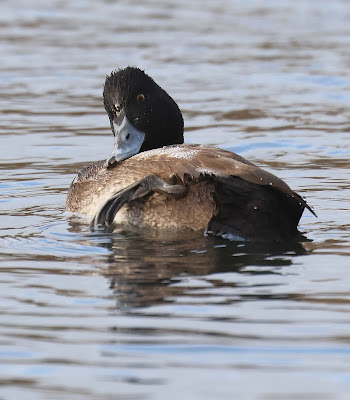Last year I was fortunate that our Christmas break coincided with a Humpbacked Whale spending a couple of weeks feeding in the Firth of Forth off Kinghorn which is but twenty minutes drive west of Lower Largo and I went out twice on a charterboat to see it.
This year the whale had not returned but there was the not inconsiderable attraction of a Stejneger's Scoter, a first for Britain that had been found amongst the large numbers of Common and Velvet Scoters that winter in Aberlady Bay on the south side of the firth. Unfortunately Aberlady Bay lies directly opposite Largo Bay which is on the north side of the firth. I planned to maybe try my luck after Christmas which would entail quite a long drive around Edinburgh in order to get to Aberlady Bay. However the scoter has, up to now proved very elusive and recently has not been seen for quite a number of days although it is probably still there but well out to sea. We will have to wait and hope.
A minor compensation has come in the form of almost daily reports of a Lesser Scaup frequenting a small body of water called Kinghorn Loch and I resolved to try and see it when time allowed, for Kinghorn Loch, as mentioned is relatively close by to Lower Largo.This would mean no domestic aggravation caused by my being absent for a long period.
As with all rare ducks in Britain this one's provenance is unknown but there is no reason to suspect it is anything other than wild. Great care also has to be taken that any such duck is not a hybrid.There are many examples of ducks looking the part but on close scrutiny turn out to be not the real deal. I can recall such a duck on my local Farmoor Reservoir in Oxfordshire being first identified as a definite male Lesser Scaup but, on consultation of photos showing the open wing pattern, it proved to be a hybrid Greater Scaup x Lesser Scaup and probably an escape from a wildfowl collection. A birder who had never seen a Lesser Scaup even travelled all the way from Scotland to see it before it was re-identified as a hybrid. Ouch!
The Lesser Scaup is the most abundant diving duck in North America with a population approaching three million but declining. They breed as far north as Alaska, western Canada and the northern states of the USA and migrate to winter further south in the USA and as far south as northern parts of South America.
Until comparatively recently it occurred regularly in Britain and although still a rarity was no longer considered the extreme rarity it used to be. It was first recorded in Britain at Chasewater, Staffordshire in 1987. Since then there have been enough records of its occurrence in Britain to cause it to be removed, in 2015, from the list of rare species to be considered by the BBRC ( British Birds Rarities Committee) but after a subsequent decade of decline, that produced only 66 records, it was reinstated in 2020. Contrarily in 2021 there followed a major influx (possibly the largest ever) of this species into western Europe with at least fourteen records in Britain alone compared to a previous annual average of two or three per year.
Christmas Eve provided the first opportunity to go and see the scaup as Mrs U had decided on a long walk around Largo Bay and was happy to go on her own so long as I promised to be back by lunchtime. I set off for Kinghorn on a sunny almost windless morning. The loch lies right by the road and parking in a layby I followed a muddy footpath that took me down through woodland to the loch side. The scaup had already been reported that morning so I was eagerly anticipating getting to see it. My hope of success was however to prove premature when I saw a large boat being rowed by six people around the loch, scattering ducks from one end of the loch to the other.
The only ducks present that I could see were five agitated Common Goldeneye and a couple of Tufted Ducks, while up to ten Little Grebes concealed themselves below the overhanging vegetation of the lochside banks. Of the Lesser Scaup there was a conspicuous absence and I could only assume it had departed for somewhere quieter due to the continuing disturbance from the boat which frustratingly continued its circling of the loch with no sign of ceasing anytime soon.
There is nothing to do in such a circumstance than to quietly curse one's bad luck and accept the situation for what it is. Nevertheless I scoped every part of the loch repeatedly but it was obvious the scaup had gone. The rowers finally brought their craft to shore and I now found myself thinking what to do next. Should I wait and hope the scaup would return or give it up as a lost cause. I was also running out of time.
I looked at the Ordnance Survey Map app on my phone to see if there were any other waterbodies nearby and found only one which was a boating lake within Beveridge Park, which lies at the back of the town of Kirkcaldy,through which I had passed on the way to Kinghorn. As Kirkcaldy was on my route back to Lower Largo I resolved the park's lake might be worth a brief look although it sounded far from promising.
Fifteen minutes later I parked my car in the wintery green acres of Beveridge Park which is a pleasant recreational area of playing fields, a bowling green, the aforesaid lake and a children's play area. It was sparsely populated today as I made my way to the tarmac path that circumvented the lake and joined just one local birder looking at the ducks and gulls through his scope
My spirits sank as on arriving at the side of the lake I could see that most of it was frozen, with a large number of Black headed Gulls standing about on the ice. An island in the middle of the lake had some clear water under some trees and there was another patch of open water right by the lake's edge and close to me that was populated by ten or so Tufted Ducks.
.jpg) |
| Beveridge Park Boating Lake |
I found myself hoping the scaup would, by some miraculous chance, be amongst these close Tufted Ducks that were swimming and diving only metres away but that would be asking too much and so it transpired. With my bins I then looked over towards the island where a few more Tufteds and the odd Mallard were either loafing or asleep on the small area of open water there. A line of Tufted Ducks were idly cruising in the water and there on the left was the Lesser Scaup.
 |
| Lesser Scaup on extreme left with four Tufted Ducks |
Quite distinctive compared to its companions, its plumage looked frosted on parts of its predominantly brown body due to emerging pale grey patches, closely and coarsely vermiculated with black on its upperparts and flanks, the latter slightly paler and with finer vermiculations than its upperparts. Being a first winter bird it was in a messy transitional plumage moving from the predominantly brown of a juvenile to that of an adult male.
It was reasonably distant but unknowingly I was soon to be rewarded with much closer views. An irascible Coot began hassling the Tufted Ducks and when a female Goosander surfaced close by it was too much and the Tufteds flew to the other area of water right by the path. For a moment the scaup remained where it was and it was a tense few seconds watching it confusedly swimming around before it too flew across the ice to rejoin its Tufted Duck companions.
Here was a golden opportunity and approaching slowly I crouched just metres away from the scaup as it paddled around in the small area of water. At first tense and alert it then relaxed as its companions showed no alarm at my approach and commenced to dive and preen.
 |
| The Lesser Scaup showing the diagnostic feature of only the nail on its upper mandible being black |
For half an hour I watched and photographed the Lesser Scaup as various passers by walked within metres of it and the Tufted Ducks.
Slowly the light began to fade on a day that was only just past the winter solstice and I left to return to the car and make my way back to Lower Largo.
A nice pre Christmas present for this festive season


.jpg)
















Some people get all the jam! Well done on re-finding the target bird.
ReplyDeleteThank you Nic. Splendid effort to see the magic 300 in 2022 and all the best to you and Anne for 2023
Delete